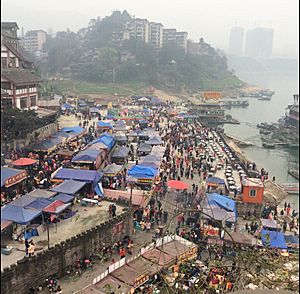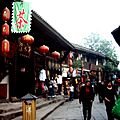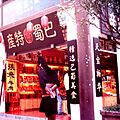Ciqikou, Chongqing facts for kids
Ciqikou (pronounced See-chee-koh) is an amazing old town in the city of Chongqing, China. It was once called Longyinzhen, and some people even called it "Little Chongqing." There's an old saying that goes, "One flagstone road, and one thousand years' Ciqikou." This means the town has a long history!
Ciqikou got its name from making beautiful porcelain during the Ming (1368–1644) and Qing Dynasties. It used to be a very busy port on the Jialing River. Even after a thousand years, Ciqikou still shows what old Chongqing was like.
Contents
Where is Ciqikou?
Ciqikou is located on the west side of the Jialing River. It covers an area of about 1.18 square kilometers (that's about 0.45 square miles). Three mountains, Jingbi, Fenghuang, and Ma'an, surround Ciqikou. Two springs, Fenghuang Quan and Qinshui Quan, also flow through it. Local people believe the way Ciqikou is shaped brings good luck and harmony, which is called Fengshui.
A Glimpse into History
Records show that Ciqikou was first built a very long time ago, around the year 998, during the Song Dynasty. It became very important during the Ming Dynasty as a busy place for trade. Goods were moved by both land and water. The town was at its busiest at the end of the Qing Dynasty. People used to say, "one thousand people greet each other during the day... ten thousand lamps flicker at night." This shows how lively and full of people Ciqikou was!
Ciqikou Today
Today, both people visiting Chongqing and those who live there love to explore Ciqikou's narrow, hilly streets. You can find shops selling beautiful porcelain, other handmade crafts, and gifts. Restaurants and tea shops offer a taste of what Chongqing was like before it became a huge modern city. There's even a 1,500-year-old Buddhist temple on the mountain in the middle of the old town.
Ciqikou is also known for its special "Baci culture." Many famous people lived here during the Second Sino-Japanese War. These included writers like Guo Moruo and Ba Jin, and artists like Xu Beihong. Even a famous scientist named Ding Zhaozhong studied here when he was a child.
Fun Customs and Traditions
Ciqikou is full of interesting customs that have been passed down for many years. Some of these include:
- Baibazi: A traditional way of telling fortunes.
- Xingbang: A type of folk art performance.
- Family's ancestral temple: Places where families honor their ancestors.
- Pao Brother: A traditional local group.
- Temple fair: Lively festivals held at temples.
- Dragon dance: A traditional performance with a long dragon costume.
- Dragon boat race: Exciting races held on the water.
- Friends of Sichuan opera: Groups who enjoy and perform local opera.
- Chuntai drama: A type of traditional play.
- Pingshu: Traditional storytelling.
- Teahouse culture: Enjoying tea and conversation in special tea houses.
Delicious Food to Try
Chongqing is famous for its many local foods, especially the spicy "hotpot." Ciqikou is one of the best places to try these delicious dishes. Some of the most popular foods in Ciqikou are:
- Jiaoyan Peanut: A salty peanut snack.
- Maoxuewang: A spicy and flavorful dish.
- Qianzhangpi: A type of bean curd skin.
These three are often called the "three treasures of Ciqikou." You can also try Douban fish, which is a tasty fish dish.
Important Landmarks
Compound of Zhong's
This old house is over 120 years old! It was built by a man named Zhong Yunting during the late Qing Dynasty. He worked for the Empress Dowager Cixi, a powerful ruler. The house shows off traditional Chinese building styles from both the northern and southern parts of China.
Bayu Dwellings Collection
When you walk into the Bayu Dwellings, made of wood, stone, and brick, you might feel like you've stepped back in time. These old homes give visitors a peaceful feeling and a look at how people used to live.
Bao Lun Buddhist Temple
The Jianwen Emperor of the Ming Dynasty lived here after he was removed from power. The large Chinese characters "大雄宝殿" (dà xióng bǎo diàn) hanging at the temple were written by Zhao Puchu, a famous calligrapher. The main building of the temple was built 600 years ago during the Ming Dynasty. It's amazing because it was built without using a single nail! This is seen as a miracle in Chinese architecture. Many Buddhist followers visit this temple to pray, especially during the Chinese New Year.
Han Lin Academy
The Han Lin Academy in Ciqikou used to be a school run by the Sun family during the Qing Dynasty. The family's children and other students studied there. Three of them even passed a very difficult national exam, which made the academy very famous. Because of its good reputation, many smart people and students came to the Han Lin Academy in Ciqikou.
Images for kids





